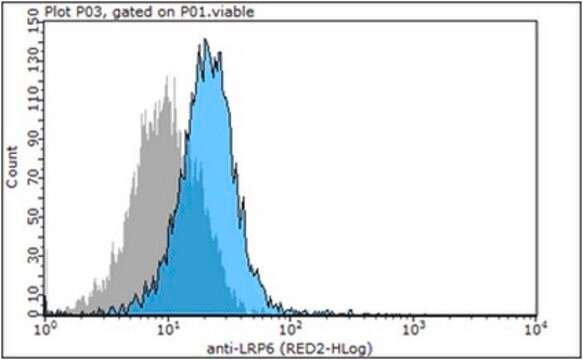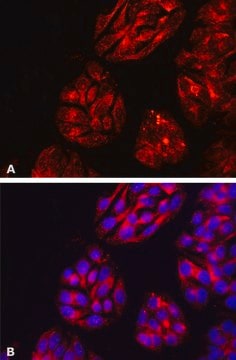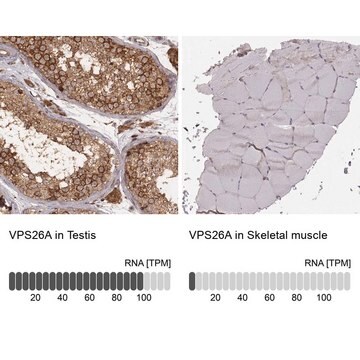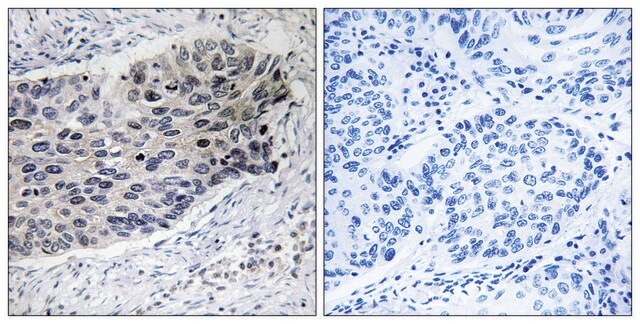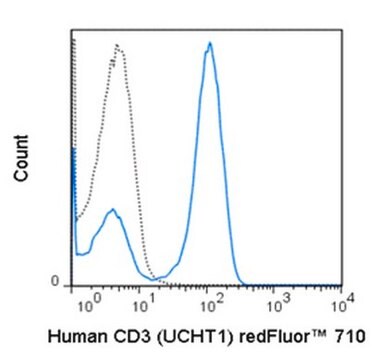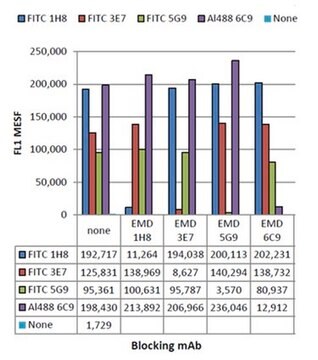CBL150-I
Anti-CD3e Antibody, clone UCHT1
clone UCHT1, from mouse
Sinonimo/i:
T-cell surface glycoprotein CD3 epsilon chain, CD3-epsilon, CD3e, T-cell surface antigen T3/Leu-4 epsilon chain
About This Item
Prodotti consigliati
Origine biologica
mouse
Livello qualitativo
Forma dell’anticorpo
purified immunoglobulin
Tipo di anticorpo
primary antibodies
Clone
UCHT1, monoclonal
Reattività contro le specie
human
tecniche
ELISA: suitable
flow cytometry: suitable
immunocytochemistry: suitable
immunohistochemistry: suitable
immunoprecipitation (IP): suitable
Isotipo
IgG1κ
N° accesso NCBI
N° accesso UniProt
Condizioni di spedizione
dry ice
modifica post-traduzionali bersaglio
unmodified
Informazioni sul gene
human ... CD3E(916)
Descrizione generale
Specificità
Immunogeno
Applicazioni
ELISA Analysis: A representative lot was used as the capture antibody for the detection of epsilon-associated TCR complex proteins by sandwich ELISA (Poggi, A., et al. (1996). Int. Immunol. 8(12):1947-1953).
Immunocytochemistry Analysis: A representative lot detected the exogensously expressed human CD3 epsilon chain on the surface of murine T cells by flourescent immunocytochemistry (Clevers, H., et al. (1988). Eur. J. Immunol. 18(5):705-710).
Immunocytochemistry Analysis: A representative lot was employed to determined the plasma membrane and cytoplasmic CD3 immunoreactivity in T cell populations and T-ALL blast cells by flourescent immunocytochemistry (Campana, D., et al. (1987). J. Immunol. 138(2):648-655).
Immunohistochemistry Analysis: A representative lot detected CD3+ T cells (T3+) in the periglandular stromal aggregates in frozen dometrium sections from female donors undergone routine dilation and curettage procedures (Kamat, B.R., and Isaacson, P.G. (1987). Am. J. Pathol. 127(1):66-73).
Affects Function: A representative lot induced surface IL-2R expression and proliferation of human peripheral blood T lymphocytes (Van Wauwe, J.P., et al. (1984). J. Immunol. 133(1):129-132).
Flow Cytometry Analysis: A representative lot was employed for fluorescence activated cell sorting (FACS) of CD3+ human lymphocytes (Beverley, P.C., and Callard, R.E. (1981). Science. 11(4):329-334).
Inflammation & Immunology
Immunological Signaling
Qualità
Flow Cytometry Analysis: 0.1 µg of this antibody detected CD3e in 1X10E6 human PBMC.
Descrizione del bersaglio
Stato fisico
Stoccaggio e stabilità
Handling Recommendations: Upon receipt and prior to removing the cap, centrifuge the vial and gently mix the solution. Aliquot into microcentrifuge tubes and store at -20°C. Avoid repeated freeze/thaw cycles, which may damage IgG and affect product performance.
Altre note
Esclusione di responsabilità
Non trovi il prodotto giusto?
Prova il nostro Motore di ricerca dei prodotti.
Raccomandato
Codice della classe di stoccaggio
12 - Non Combustible Liquids
Classe di pericolosità dell'acqua (WGK)
WGK 2
Punto d’infiammabilità (°F)
Not applicable
Punto d’infiammabilità (°C)
Not applicable
Certificati d'analisi (COA)
Cerca il Certificati d'analisi (COA) digitando il numero di lotto/batch corrispondente. I numeri di lotto o di batch sono stampati sull'etichetta dei prodotti dopo la parola ‘Lotto’ o ‘Batch’.
Possiedi già questo prodotto?
I documenti relativi ai prodotti acquistati recentemente sono disponibili nell’Archivio dei documenti.
Il team dei nostri ricercatori vanta grande esperienza in tutte le aree della ricerca quali Life Science, scienza dei materiali, sintesi chimica, cromatografia, discipline analitiche, ecc..
Contatta l'Assistenza Tecnica.